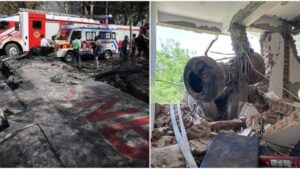On a fateful day in June 2025, Air India Flight AI-171, a Boeing 787-8 Dreamliner, took off from Ahmedabad’s Sardar Vallabhbhai Patel International Airport, bound for London Gatwick. The flight, carrying 242 passengers and crew, was expected to be a routine journey. But just 36 seconds after liftoff, the aircraft plummeted into a residential area, erupting into a massive fireball that claimed the lives of nearly all on board and several people on the ground. The tragedy, one of the deadliest in recent aviation history, left a nation in mourning and the world demanding answers. Now, with the recovery of the plane’s black boxes, investigators have uncovered a chilling revelation: a minor mistake by the co-pilot may have triggered the catastrophic chain of events. This article delves into the details of the crash, the critical role of the black box data, and the human factors that turned a small error into a devastating disaster.
The Crash: A Sudden and Violent End
The sequence of events unfolded with terrifying speed. Flight AI-171 departed Ahmedabad at 1:39 PM local time, with clear skies and no immediate signs of trouble. Captain Sumit Sabharwal, a seasoned pilot with over 8,200 flight hours, was at the helm, assisted by co-pilot Clive Kunder, who had 1,100 hours of flying experience. Moments after takeoff, Sabharwal issued a desperate “Mayday” call, reportedly stating, “No thrust, losing power, unable to lift.” Seconds later, the plane veered off course, crashing into a medical hostel and canteen complex near the airport. The impact unleashed a fireball that engulfed the wreckage, making rescue efforts nearly impossible. Only one passenger survived, while 241 others on board and at least 19 people on the ground perished.

The crash site was a scene of unimaginable destruction. Emergency responders worked tirelessly to extinguish the flames and recover remains, while investigators from India’s Aircraft Accident Investigation Bureau (AAIB) began the daunting task of piecing together the cause. Early speculation ranged from mechanical failure to fuel contamination, but the recovery of the plane’s black boxes offered hope for concrete answers.
The Black Box: A Window into the Final Moments
In modern aviation, black boxes—comprising the Flight Data Recorder (FDR) and Cockpit Voice Recorder (CVR)—are the most critical tools for understanding crashes. Despite their name, these devices are painted bright orange to aid recovery in wreckage. The FDR captures hundreds of flight parameters, such as airspeed, altitude, engine performance, and control inputs, while the CVR records all cockpit audio, including pilot conversations, alarms, and ambient sounds. Together, they provide a detailed timeline of a flight’s final moments.
For Flight AI-171, recovering the black boxes was a challenge. The intense heat of the fireball and the scattered debris complicated the search. On June 13, one black box was found on the rooftop of a building at the crash site, and on June 16, the second was located amid the wreckage. Both devices were damaged, raising concerns about whether their data could be retrieved. Initial reports suggested the boxes might need to be sent to the United States for forensic analysis, but the AAIB’s advanced laboratory in Delhi, recently upgraded with support from Hindustan Aeronautics Ltd., proved capable of the task.

By June 25, investigators successfully accessed the memory modules of both black boxes, downloading 100% of the data. The CVR captured the pilots’ final communications, including Sabharwal’s distress call, while the FDR provided a second-by-second account of the plane’s performance. As the AAIB began analyzing this treasure trove of information, a startling finding emerged: the crash may have stemmed from a minor error by the co-pilot, Clive Kunder.
The Co-Pilot’s Mistake: A Fatal Misstep
Aviation experts familiar with Boeing 787 operations have pointed to a possible human error as the catalyst for the disaster. In the critical moments after takeoff, the co-pilot was responsible for retracting the landing gear to reduce drag and ensure a smooth climb. However, preliminary analysis of the black box data suggests Kunder may have mistakenly retracted the wing flaps instead. Flaps are essential for generating lift during takeoff, and retracting them prematurely can cause a sudden loss of lift, especially at low speeds.
This error, while minor in isolation, had catastrophic consequences. The FDR data indicated that the plane failed to gain sufficient altitude, and the CVR captured alarms signaling a stall warning. The pilots had mere seconds to react, but the loss of lift and thrust—possibly compounded by other factors—made recovery impossible. The plane’s ram air turbine (RAT), a backup power system that deploys in case of engine or electrical failure, was observed in video footage, suggesting a severe power loss. The combination of these factors sent the Dreamliner into an unrecoverable descent.

Human error in aviation is not uncommon, but its impact depends on the context. In high-stakes environments like a cockpit, even small mistakes can trigger a cascade of failures, especially during the critical phases of takeoff and landing. The co-pilot’s relative inexperience compared to the captain may have played a role, but investigators are also examining whether fatigue, inadequate training, or cockpit miscommunication contributed to the error.
The Investigation: Beyond the Cockpit
While the co-pilot’s mistake is a focal point, the AAIB is conducting a comprehensive investigation to identify all contributing factors. Mechanical issues, such as engine failure or fuel system problems, remain under scrutiny. The FDR data showed no thrust from the engines, aligning with Sabharwal’s “no thrust” distress call. Possible causes include contaminated fuel, bird strikes, or a malfunction in the engine control systems. The Boeing 787’s advanced technology, including its redundant systems, is designed to prevent such failures, making the loss of both engines highly unusual.
The investigation is also exploring external factors, such as air traffic control instructions or environmental conditions. Ahmedabad’s airport is situated in a busy urban area, and the crash’s impact on a residential complex has raised questions about airport safety protocols. The AAIB, working with international partners like the U.S. National Transportation Safety Board (NTSB), aims to reconstruct the sequence of events and recommend measures to prevent future tragedies.
The Human Toll: A Nation in Mourning
Beyond the technical details, the crash of Flight AI-171 is a human tragedy of immense proportions. Families across India and beyond are grieving the loss of loved ones, from passengers embarking on vacations or business trips to students and staff at the medical hostel. The sole survivor, a passenger who miraculously escaped the wreckage, remains in critical condition, their story a faint glimmer of hope amid the devastation.
The pilots, Captain Sabharwal and co-pilot Kunder, were mourned as dedicated professionals who faced an impossible situation. Sabharwal’s quick thinking in issuing a distress call provided investigators with a critical clue, while Kunder’s family has expressed profound sorrow, emphasizing his passion for aviation. The crash has also sparked public outcry over aviation safety, with calls for stricter regulations and enhanced pilot training.
Lessons for the Future
The recovery of the black box data marks a significant step toward understanding the Air India disaster, but the investigation is far from over. Crash probes often take months or even years to complete, as investigators analyze every detail to ensure no stone is left unturned. The findings will likely lead to changes in aviation protocols, from pilot training to aircraft maintenance and emergency procedures.
For now, the revelation of the co-pilot’s minor mistake serves as a sobering reminder of the fragility of flight. In an industry where safety is paramount, even the smallest error can have unimaginable consequences. As the world awaits the AAIB’s final report, the memory of Flight AI-171 and its victims drives a collective resolve to make air travel safer for all.




